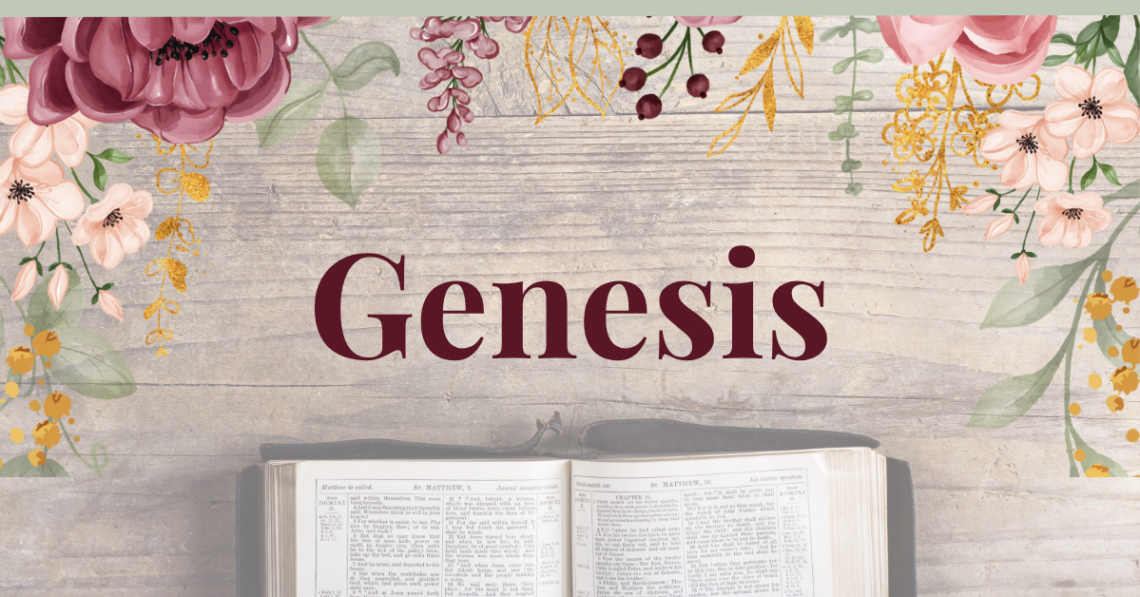The Book of Genesis is the foundational text of the Bible. It offers profound insights into the origins of the universe, humanity, sin, and God’s relationship with His creation. It’s also where we can begin to see hints and foreshadowing of Jesus Christ, the central figure of Christianity. In this post, we’ll explore the key themes and structure of Genesis, its significance, and how Jesus can be seen throughout its pages.
Background of Genesis
The word “Genesis” comes from the Greek word geneseos, meaning “origin” or “beginning.” As the first book of the Bible, Genesis explains the origins of the world, humanity, and God’s covenant people, Israel. While Moses is traditionally credited as the author, writing around 1400 B.C., Genesis is more than just history. It lays the foundation for God’s plan of redemption through Christ, starting from creation itself.
Genesis is divided into two major sections: The Primeval History (Chapters 1–11) and The Patriarchal History (Chapters 12–50). These sections detail the origins of humanity and the specific lineage that will bring forth God’s promise.
The Primeval History (Genesis 1–11)
The first part of Genesis presents the universal history of humanity, focusing on creation, the fall, and God’s judgment on sin. Even here, we see shadows of Jesus’ future role in redeeming humanity.
Creation (Chapters 1–2)
In Genesis 1, God creates the world by speaking it into existence. According to the New Testament (John 1:1-3), Jesus is identified as the Word through whom all things were made, showing that He was present and active in creation. Jesus, as the “Light of the World” (John 8:12), can also be seen in the creation of light (Genesis 1:3).
The Fall and the Promise of Redemption (Chapter 3)
After Adam and Eve’s sin, God announces consequences for the serpent. He says that the offspring of the woman will crush his head (Genesis 3:15). This verse, often called the Protoevangelium (first gospel), is the first direct prophecy of Jesus in the Bible. It foretells Christ’s victory over Satan and sin, a victory fulfilled through His death and resurrection.
The Sacrifice of Abel (Chapter 4)
Abel’s sacrifice was pleasing to God because it involved bloodshed. This prefigures the sacrificial system that would point to Jesus as the ultimate sacrificial Lamb (Hebrews 12:24).
The Flood and Noah’s Ark (Chapters 6–9)
The story of Noah’s Ark serves as a type of Christ. Just as the ark saved Noah and his family from the flood, Jesus is the means by which humanity is saved from the flood of sin and destruction (1 Peter 3:20-21).
The Patriarchal History (Genesis 12–50)
The second part of Genesis shifts focus to the patriarchs, starting with Abraham, through whose lineage the Messiah would come.
The Promise to Abraham (Chapter 12)
God promises Abraham that all nations will be blessed through him (Genesis 12:3). This is fulfilled in Jesus, a descendant of Abraham, who brings salvation to the whole world (Galatians 3:8,16).
The Sacrifice of Isaac (Chapter 22)
Perhaps the clearest foreshadowing of Jesus in Genesis occurs in the story of Abraham’s near-sacrifice of Isaac. Isaac, Abraham’s beloved son, is offered as a sacrifice, but God provides a ram in his place. This points to Jesus as God’s only Son, whom He did not withhold but offered as a substitute for us (Romans 8:32). Mount Moriah, where Abraham went to sacrifice Isaac, is believed to be the same region where Jesus would later be crucified.
Jacob’s Ladder (Chapter 28)
In Jacob’s dream, he sees a ladder reaching from heaven to earth, with angels ascending and descending on it. Jesus refers to Himself as this “ladder” or “stairway” when He tells Nathanael that He is the connection between heaven and earth (John 1:51).
Joseph and Jesus (Chapters 37–50)
Joseph’s life is filled with parallels to Jesus. He is betrayed by his brothers, sold for silver, and later rises to power, saving many lives during a famine. Similarly, Jesus is betrayed by His people, sold for silver, and rises to save humanity. Joseph’s forgiveness of his brothers mirrors Jesus’ forgiveness and grace toward sinners.
Where You Can See Jesus in Genesis
In Creation: Jesus is present in the creation narrative as the divine Word through which all things were made. His role in creation points to His eternal existence and active role in shaping the world (John 1:1-3, Colossians 1:16-17).
In the Fall and Promise of Redemption: Genesis 3:15 speaks directly of a coming “offspring” of the woman who would defeat the serpent. Jesus is the fulfillment of this promise, bruising the serpent’s head by conquering sin and death.
In the Ark of Noah: Noah’s Ark is a symbol of salvation. Just as those who entered the ark were saved from the flood, those who come to Jesus are saved from the judgment of sin.
In Abraham’s Seed: The promise to Abraham that through his seed all nations would be blessed finds its fulfillment in Jesus, who is the ultimate blessing to the nations through His work on the cross (Galatians 3:16).
In Isaac’s Sacrifice: The near-sacrifice of Isaac is a striking foreshadowing of Christ’s sacrifice. Both Isaac and Jesus were beloved sons, both were willing, and both were offered on the altar. Yet, where Isaac was spared, Jesus became the ultimate sacrifice for our sins.
In Jacob’s Ladder: Jesus is the bridge between heaven and earth, as indicated by the ladder in Jacob’s dream. He is the way by which humanity can access God, fulfilling the promise of reconciliation between God and man.
In Joseph’s Story: Joseph’s life of suffering and eventual exaltation is a picture of Jesus. Like Joseph, Jesus was rejected and betrayed but was ultimately exalted to a place of honor, offering salvation to many.
Key Themes in Genesis
- Creation and God’s Sovereignty: Genesis establishes that God is the Creator of everything, and through Jesus, all things were made.
- Humanity’s Fall and Sin: The story of Adam and Eve’s fall demonstrates humanity’s need for a Savior, a need that Jesus fulfills.
- God’s Covenant and Redemption: God’s covenant with Abraham points forward to the new covenant established through Jesus, who blesses all nations.
- Foreshadowing Christ: Many events and figures in Genesis, like Isaac and Joseph, are types or shadows that prefigure the coming of Christ and His redemptive work.
How We Can Apply Genesis to Our Lives Today
The Book of Genesis is not just an ancient narrative. It holds powerful truths that are applicable to our lives today. Here are a few ways we can apply the lessons from Genesis:
- Recognizing God as the Creator: Understanding that God created everything gives us a sense of purpose. We were created intentionally by God, and this should influence how we view ourselves, others, and the world around us.
- Living in Light of Redemption: Just as God promised redemption in Genesis 3:15, we are reminded today that redemption through Jesus has already been secured. This should lead us to live with hope, knowing that Christ has already overcome sin and death on our behalf.
- Trusting in God’s Plan: From Abraham to Joseph, Genesis shows us that God’s plan may take unexpected turns, but He is always faithful. We can trust that even when life doesn’t make sense, God is working behind the scenes for our good and His glory.
- Responding to Grace: In the story of Joseph, we see forgiveness and grace. Just as Joseph forgave those who wronged him, we are called to extend grace to others, reflecting the grace we have received from Christ.
- Building Strong Foundations: Genesis serves as the foundation of our faith. By understanding the beginnings of the world, humanity, and God’s redemptive plan, we can strengthen our foundation in Christ and live out the truths of Scripture with confidence.
Conclusion
The Book of Genesis is not just a story of beginnings—it’s a story that ultimately points to Jesus. From the promise of redemption after the fall to the foreshadowing of His sacrifice in Isaac and Joseph’s life, we can see Christ’s presence woven throughout the text. Genesis sets the stage for understanding God’s grand plan of salvation, which comes to fulfillment in Jesus Christ. As you read Genesis, look for these glimpses of the Savior, knowing that even in the earliest days of creation, God was preparing the way for Jesus to come and redeem the world.
Call to Action
As you reflect on the themes of Genesis and how they point to Jesus, I’d love to hear your thoughts! How have you seen Christ foreshadowed in the Old Testament? Leave a comment below to share your insights, or feel free to ask any questions you may have about the connections between the Old and New Testaments. Let’s continue the conversation together! And if you found this post helpful, be sure to share it with others who might be encouraged by it.





